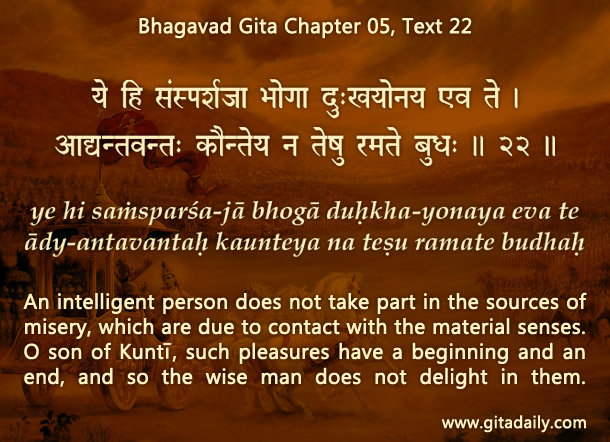Lust makes temporarily good-looking bodies seem sources of immense pleasure.
We know from our own experience with our body that it can be, indeed it is, a source of trouble: the pangs of bodily needs such as hunger and thirst, environmental problems such as excess heat or cold, physical dangers such as accidents and diseases, and ultimately the inevitable miseries of old age and death.
Others’ bodies, even if shaped differently, are made of the same perishable and vulnerable matter as our bodies. So, it’s a simple inference that they too will be sources of suffering for their possessors. Yet lust makes the body that is the source of suffering for its possessor appear to be the source of pleasure for its beholder. Actually, when two such bodies are brought together with fantasies of sensual pleasure, the net result, the Bhagavad-gita (05.22) indicates, is misery. This misery includes the misery coming from increased attachment to one’s own body, from attachment to another pain-prone body and from karmic consequences of the indulgence, especially when the indulgence is immoral.
Such a starkly negative vision of the body can be a powerful cerebral jolt to disabuse us of its glamorized cultural depictions. At a normal functional level, however, bhakti-yoga recommends a balanced vision of the body, seeing it neither as a gateway to pleasure nor as an abyss of misery, but as an essential tool for devotional service. Similarly, we see our relationships as spiritual partnerships in our shared journey towards Krishna.
By thus keeping our consciousness on Krishna and not letting it get caught in sensual fantasies, we can transform the body and even its senses into tools that connect us with Krishna, thereby taking us towards the lasting, fulfilling happiness of eternal spiritual love.

Explanation of article:

This is an eye-opening article. Yes, it is indeed so true that the material body is a source of distress for everyone. At least we know it for ourselves, i.e. we very well know that our own body is a source of misery to us. For example, if we are trying to gather focus in some important meeting, or trying to focus on our studies, we are involuntarily overcome by the unwelcome force of fatigue.
Now, it is not difficult to extrapolate this fact and generalize it to everyone’s bodies. We can easily see this around when we find people complaining about some malfunctioning of the body. Even the most attractive people have trouble with their bodies. Yet, under the illusory force of lust, this fact is forgotten and one tries to optimistically find happiness in something that is guaranteed to lead to distress.
Chaitanya Charan Prabhu has shared this wonderful realization and very generously given others an opportunity to make it their own. Thank you so much.